RT23 CPCS Blue Card Renewal Mock Test with 125 Questions and Answers / A23 Skid Steer Loader
£15.00 Original price was: £15.00.£9.95Current price is: £9.95.
Crush Your Skid Steer Loader CPCS Blue Card Renewal Test with Our Lifelike Practice Questions! Your Blueprint to Blue Card Renewal Success!
- Questions & Answers: based on the latest RT 23 Skid Steer Loader – CPCS Renewal Test Revision FACTSHEET
- Categories: A 23 – Skid Steer Loader
- Number of Multiple-choice Questions: 125
- Format: PDF
- Delivery time: Instant download after checkout
- Refunds: No refunds once downloaded, unless you ordered duplicates by mistake.
If there are any issues with your download, please email CardRenewalTest@gmail.com and we’ll send it ASAP
Master Your CPCS Blue Card Renewal with Our RT23 Skid Steer Loader Mock Practice Test
Your Key to Extending Your CPCS Blue Card for 5 More Years
Are you a Skid Steer Loader operator with an expired or expiring CPCS blue card? Do you want to renew your blue card and continue working in the industry for the next five years? We’ve got just the solution you need! Introducing our comprehensive RT23 Skid Steer Loader CPCS blue card renewal mock practice test – the perfect tool to help you pass the renewal test with flying colors.
Why You Need Our Mock Practice Test
Renewing your CPCS blue card is essential to continue working as a Skid Steer Loader operator, but it can be a daunting process. We understand that not everyone enjoys poring over long factsheets and manuals. That’s why our mock practice test is the ideal solution for you. Here’s why you need it:
1. Simplified Learning
Our mock practice test condenses all the critical information from the latest NOCN CPCS RT23 Skid Steer Loader factsheet into easy-to-understand questions and answers. No need to sift through lengthy text – we’ve done the hard work for you.
2. Realistic Exam Simulation
By using our mock test, you’ll experience what the actual CPCS blue card renewal test feels like. You’ll become familiar with the format and types of questions you can expect, reducing anxiety on the test day.
3. Comprehensive Coverage
We’ve curated 125 multiple-choice questions that cover a wide range of topics relevant to Skid Steer Loader operation. This means you’ll have a well-rounded understanding of the subject matter and a higher chance of passing the real exam.
4. Convenient and Accessible
You can access our mock practice test from the comfort of your home, office, or anywhere with an internet connection. No need to schedule classes or workshops – study at your own pace.
5. Proven Success
Countless Skid Steer Loader operators have used our mock tests to renew their blue cards successfully. They’ve found our questions and answers to be the closest thing to the actual test, giving them an edge when it matters.
What You’ll Learn
When you purchase our RT23 Skid Steer Loader CPCS blue card renewal mock practice test, you’ll gain valuable knowledge and skills, including:
- Regulations and Safety: Understand the safety guidelines, regulations, and best practices for operating a Skid Steer Loader safely.
- Machine Operation: Learn the ins and outs of Skid Steer Loader operations, including handling attachments, loading, and unloading.
- Maintenance and Inspection: Discover the importance of regular machine checks and how to ensure your Skid Steer Loader is in top condition.
- Risk Management: Gain insights into identifying potential risks and how to mitigate them to protect yourself and others on the worksite.
- Troubleshooting: Learn how to handle common issues and malfunctions that may arise during operation.
How to Pass the CPCS Blue Card Renewal Test
Ready to take the next step toward renewing your CPCS blue card and securing your future as a Skid Steer Loader operator? Follow these steps:
- Purchase Our Mock Practice Test: Visit our website and purchase the RT23 Skid Steer Loader CPCS blue card renewal mock practice test.
- Study and Practice: Use the mock test to study, learn, and practice. Take your time to understand the questions and answers thoroughly.
- Simulate Exam Conditions: Mimic exam conditions by taking the practice test in a quiet space with a time limit. This will prepare you for the real thing.
- Review Your Results: After each test, review your answers and identify areas where you need improvement. Focus on those topics in your further studies.
- Boost Your Confidence: As you practice, your confidence will grow, and you’ll feel well-prepared for the actual CPCS blue card renewal test.
- Pass the Real Exam: Armed with the knowledge and skills you’ve gained from our mock test, take the real CPCS blue card renewal test with confidence. You’ll be well on your way to renewing your card.
Don’t let an expired blue card hold you back from your Skid Steer Loader operator career. Purchase our RT23 Skid Steer Loader CPCS blue card renewal mock practice test today and enjoy the benefits of extending your blue card for the next five years. We’re here to support your success and help you keep doing what you love – operating Skid Steer Loaders.
Here is a summary of the key learning points from the official RT23 Skid Steer Loader factsheet:
Preparation:
- Skid steer loaders are used in various sectors, particularly in restricted and confined areas for material extraction and loading.
- Proper preparation is essential for safe and efficient operation.
- Manufacturers provide guidance on regular checks that must be followed to ensure the skid steer’s safety and performance.
- Operator-detected defects, even seemingly minor ones, must be reported immediately to prevent potential issues from worsening.
- Attachments can inadvertently detach during work, making it crucial for operators to ensure secure attachment.
Working Safely:
- Entry to the operating seat is typically through the front of the cab, requiring operators to check for trip hazards.
- Loader arms should be lowered and safety bars disengaged before leaving the cab.
- The engine should always be switched off when exiting the cab to prevent unintentional movement.
- Some skid steers can experience sudden lowering of loader arms due to a foot pedal, even with the engine off.
- Skid steers have been known to creep forward with the engine running and no operator in the seat.
- Leaning out of the cab to communicate with others can lead to unintentional machine movement.
- Working in congested areas necessitates planning to segregate machine movements from pedestrians.
- Consideration should be given to changes in road surfaces and adverse weather conditions, as these can affect the machine’s stability.
- Near embankments or edges, suitable barriers or earth bunds should be provided to prevent the machine from going over the edge.
- Protection measures like barriers may minimize but not entirely prevent the machine from going over an edge, which applies when tipping loads as well.
- Operators should keep a safe distance from overhead power lines, as advised by energy network utilities based on the power line’s voltage.
- Skid steers are equipped with a roll-over protective structure (ROPS) to minimize operator injuries in case of rollovers, provided the seatbelt is worn.
- To avoid instability, operators should gently control all steering and operating movements, especially when turning.
Reversing and Visibility (Travelling):
- Reversing remains a significant factor in workplace accidents, injuries, and fatalities.
- When eliminating reversing is not reasonably practicable, operations can be restricted to a segregated, controlled area.
- Skid steers do a significant amount of reversing in tight, confined areas, which limits the operator’s rear and side visibility, especially when loader arms are semi-raised.
- Additional vision aids, such as mirror systems, can help provide better visibility during operation.
- Oversized buckets or attachments can affect stability and restrict operator visibility.
Stability:
- Skid steers are less stable in certain conditions, especially when working on slopes. The operator’s handbook should be checked to determine the maximum gradient the machine can handle.
- In general, skid steers with a full bucket load should be driven forward up a slope and reversed down, with the opposite applying when the bucket is empty.
- Driving up a slope with the bucket raised can tip the machine backward due to a higher and rearward-biased center of gravity.
- Tipping a full bucket of material on a slope while facing downhill can cause the machine to tip forward.
- High production rates can lead to overturning if the center of gravity exceeds safe margins due to a raised bucket and turning action.
- Traveling with a raised front bucket on uneven ground can shift the machine’s center of gravity outside the wheel track, causing a sideways tip.
- Raising a loaded bucket can make a skid steer less stable, so loading skips or vehicles, particularly high-sided types, should be done on firm and level ground.
These summarized points cover the essential aspects of operating a Skid Steer Loader safely and efficiently as detailed in the RT23 Skid Steer Loader factsheet.
2 reviews for RT23 CPCS Blue Card Renewal Mock Test with 125 Questions and Answers / A23 Skid Steer Loader
Add a review Cancel reply
Related products
CPCS Blue Card Renewal Tests
RT19 CPCS Blue Card Renewal Mock Test with 123 Questions and Answers / A19 Grader
CPCS Blue Card Renewal Tests
RT12 CPCS Blue Card Renewal Mock Test with 130 Questions and Answers / A10, A12 Excavator 180°
CPCS Blue Card Renewal Tests
RT24 CPCS Blue Card Renewal Mock Test with 128 Questions and Answers / A24 Motorised Scraper
CPCS Blue Card Renewal Tests
CPCS Blue Card Renewal Tests
RT65 CPCS Blue Card Renewal Mock Test with 133 Questions and Answers / A65 Demolition Plant
CPCS Blue Card Renewal Tests
RT60 CPCS Blue Card Renewal Mock Test with 151 Questions and Answers / A60 Mobile Crane
CPCS Blue Card Renewal Tests
RT22 CPCS Blue Card Renewal Mock Test with 144 Questions and Answers / A22 Tracked Loading Shovel
CPCS Blue Card Renewal Tests
RT34 CPCS Blue Card Renewal Mock Test with 130 Questions and Answers / A34 Crawler Tractor Dozer



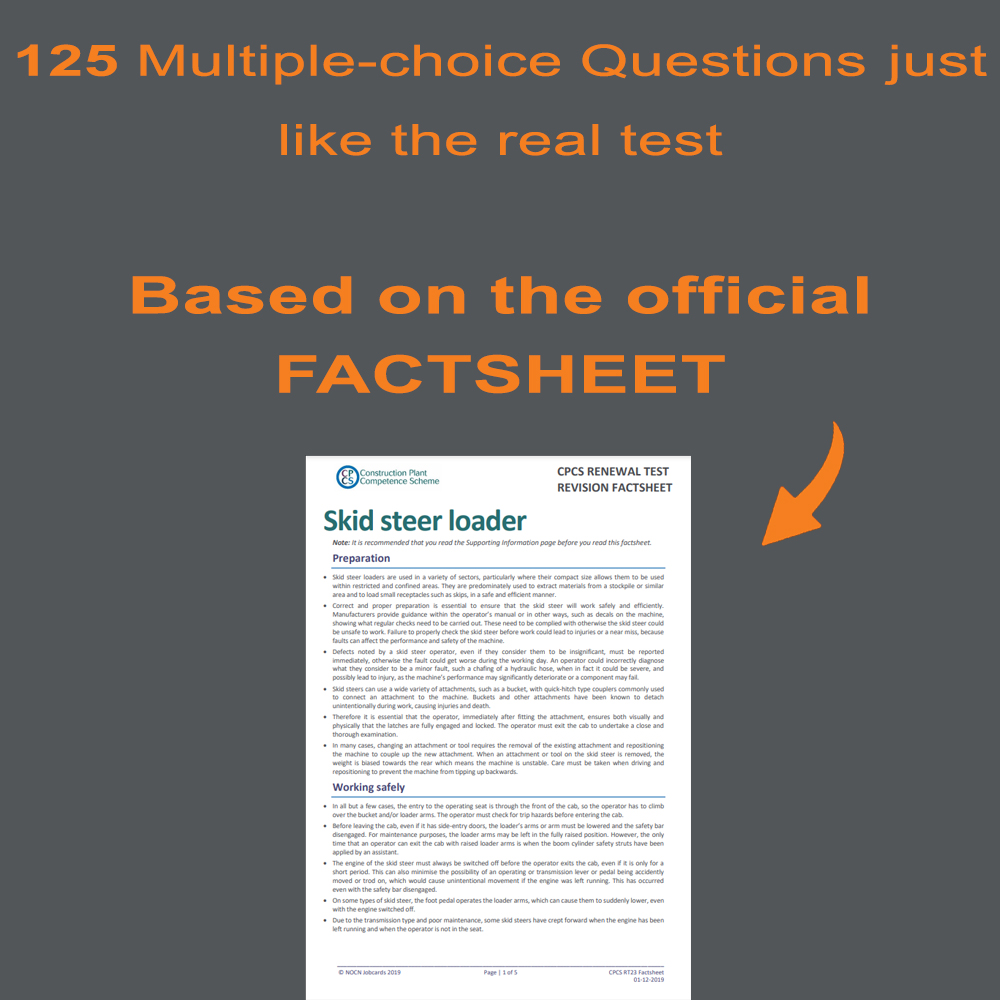
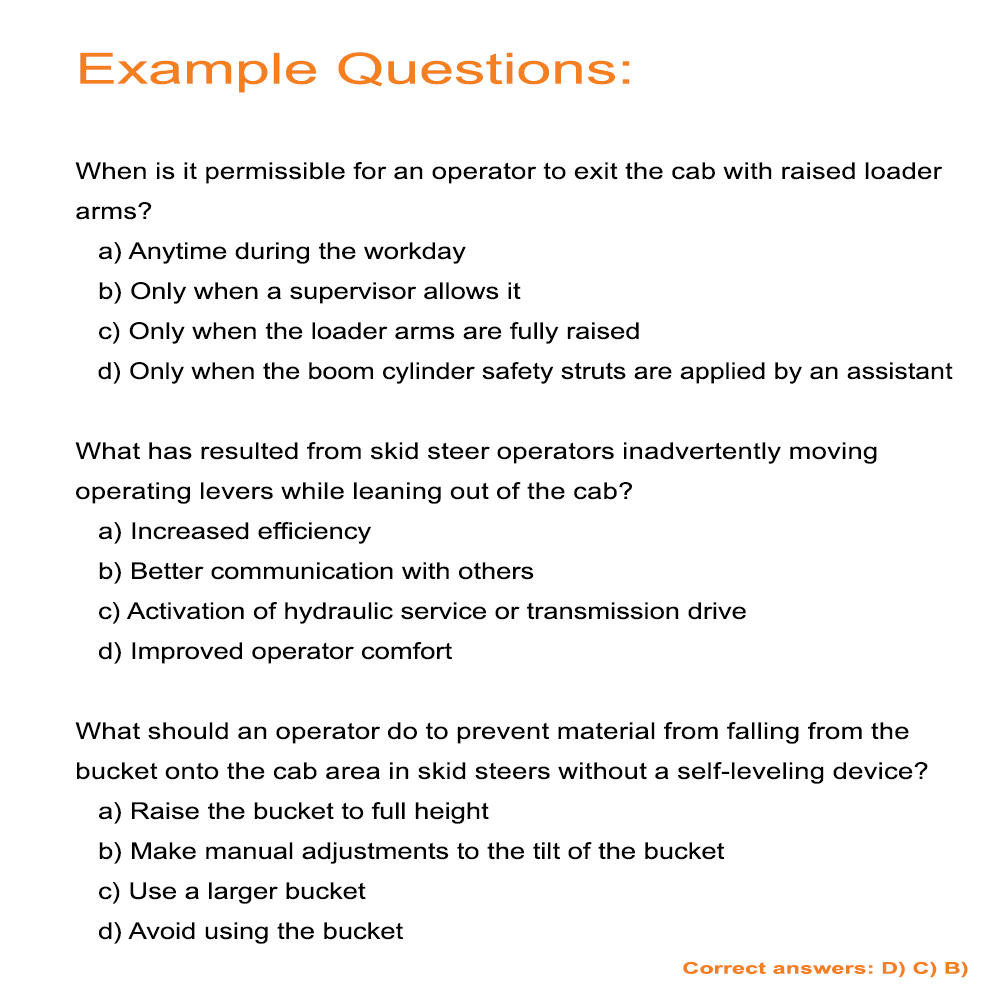
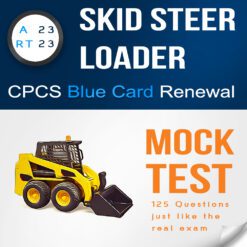



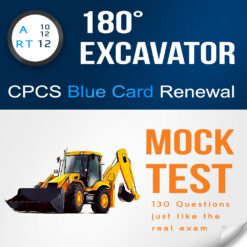
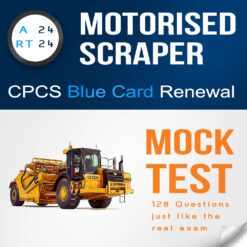



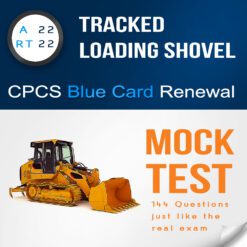
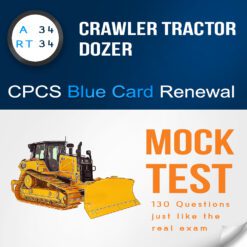
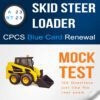
Jas –
Good job mate donno how you made this but well worth the read before the test. I passed thanks
Daniel Turner –
Passed tnx